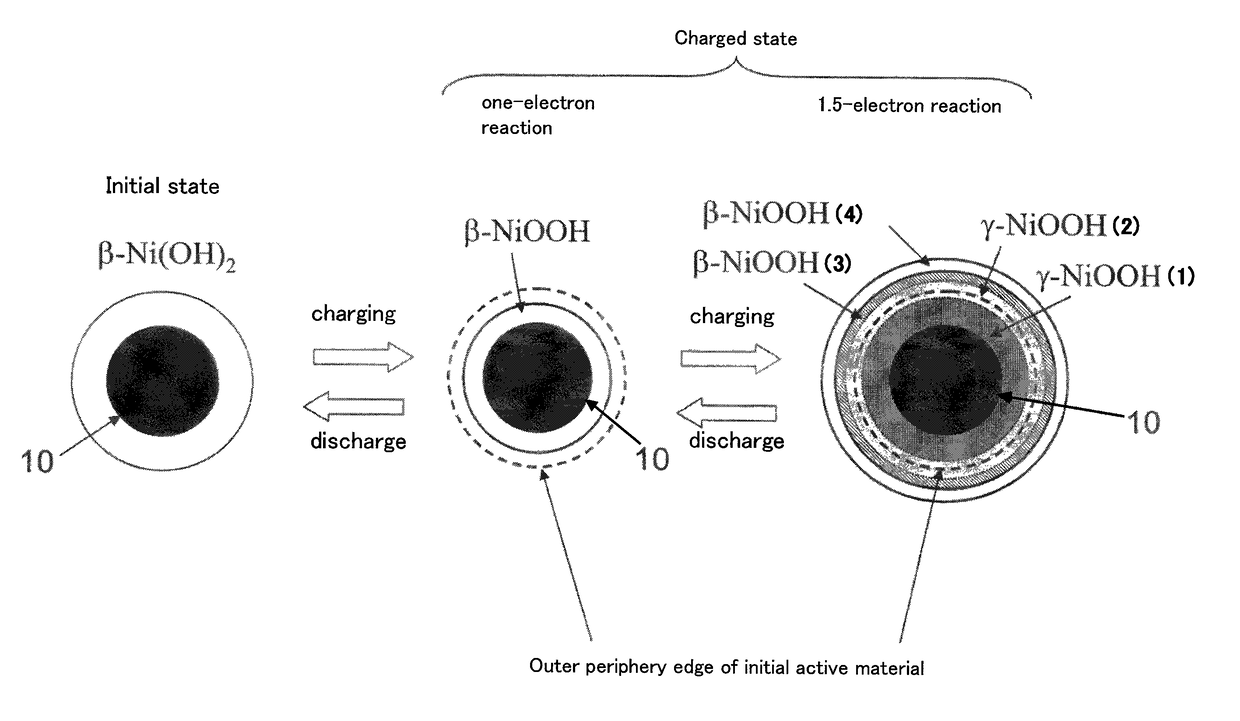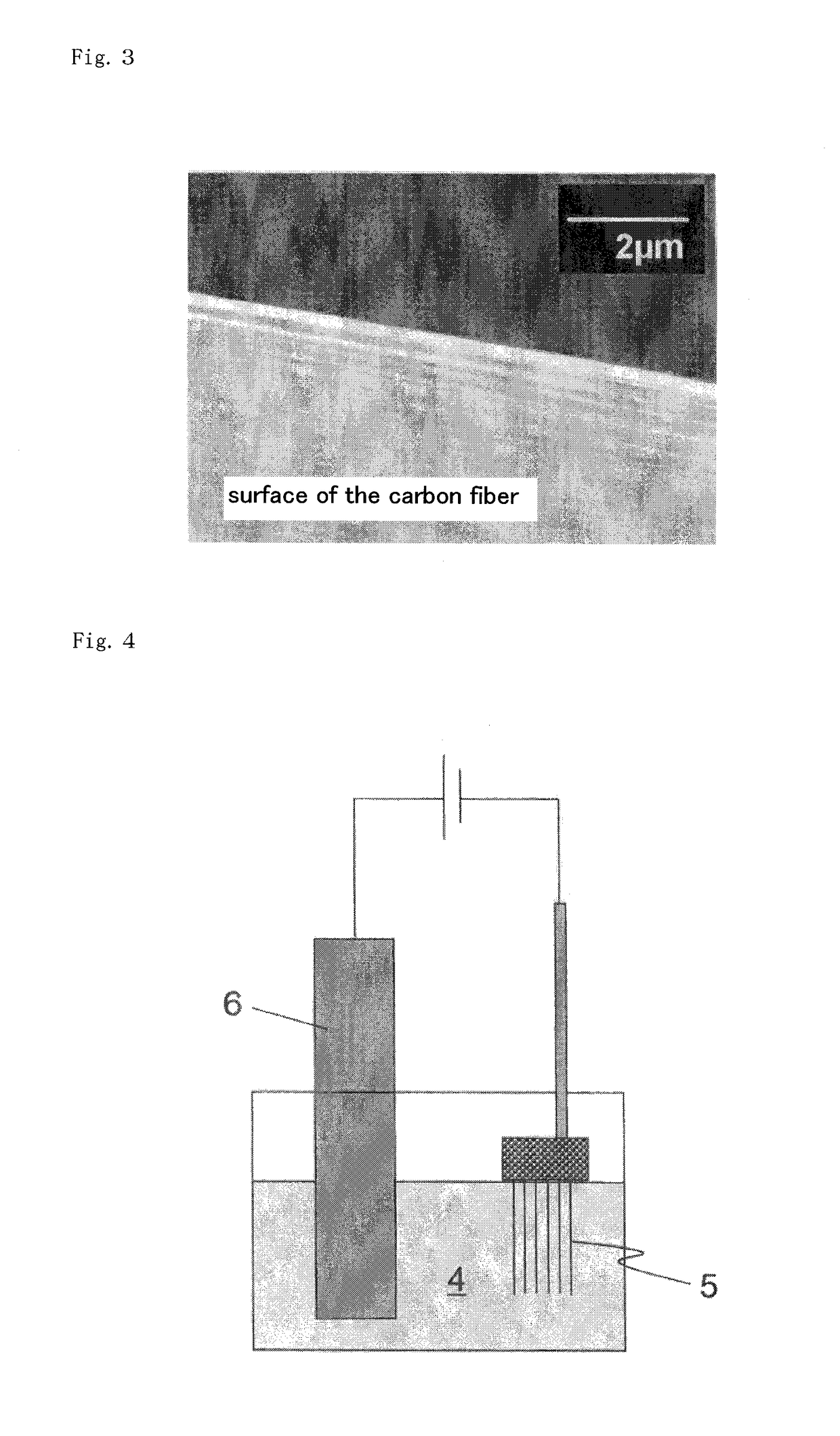Nickel positive electrode for fiber battery
a positive electrode and fiber battery technology, applied in the field of nickel positive electrodes for fiber batteries, can solve problems such as not developing a practical level, and achieve the effects of high capacity, long life duration and high outpu
- Summary
- Abstract
- Description
- Claims
- Application Information
AI Technical Summary
Benefits of technology
Problems solved by technology
Method used
Image
Examples
example 1
[0089]As graphite fibers (graphitized twist yarn produced using two strings of a commercially available polyacrylonitrile fiber) configuring an electricity collector, those having an average diameter of 12 μm were used. Each monofilament configuring this fiber has an average diameter of 6 μm.
[0090]After this graphite fiber is subjected to electroless nickel plating by a deposition method with nickel-boron alloy (boron: 1%) plating using a reductive action of dimethylamine borane, electrolytic nickel plating was carried out. The electrolytic nickel plating was carried out using a plating bath containing 350 g / L nickel sulfate, 45 g / L nickel chloride and 42 g / L boric acid as principal components, i.e., Watts-type bath, generally referred to. Specifically, 3,000 strings of graphite fiber having a length of 50 mm were sandwiched between two foamed nickel pieces and crimped to fix, and placed into Watts-type bath as a terminal. As a counter electrode, a nickel plate having a thickness of...
example 2
[0117]In order to examine an effect of addition of aluminum hydroxide to nickel hydroxide, a solution for electrolytic deposition was prepared by adding 5,000 g of water to 1,600 g of nickel nitrate (hexahydrate) and 420 g of aluminum nitrate (nonahydrate), and adjusting the pH to 5. Electrolytic deposition was carried out in this solution with as a cathode the fibrous electricity collector obtained similarly to Example 1 and subjected to nickel plating, the nickel plate as an anode, and a nonwoven polypropylene fabric as a separator provided between both electrodes. Electrodeposition conditions involved an electric current density of 20 mA / cm2, and an electrolytic deposition time of 10 min. In this case, nickel hydroxide and aluminum hydroxide were electrodeposited, and the electrolytic deposition efficiency thereof was about 42%. The content of aluminum hydroxide was 22% by mole of metal equivalent (i.e., in terms of aluminum with respect to nickel). The mixed layer of nickel hydr...
example 3
[0122]In order to examine an effect of addition of a conductant agent and a binder to nickel hydroxide, a solution for electrolytic deposition was prepared by adding 5,000 g of water to 2,000 g of nickel nitrate (hexahydrate), 85 g of a particulate carbon material and 21 g of PVA, and adjusting the pH to 5. Electrolytic deposition was carried out in this solution with as a cathode the fibrous electricity collector obtained similarly to Example 1 and subjected to nickel plating, the nickel plate as an anode, and a nonwoven polypropylene fabric as a separator provided between both electrodes. Electrodeposition conditions involved an electric current density of 20 mA / cm2, and an electrolytic deposition time of 10 min. In this case, nickel hydroxide was electrodeposited concomitant with deposition of particulate carbon material and PVA, and the electrolytic deposition efficiency thereof was about 39%. The content of the particulate carbon material was 20% by weight. The mixed layer of n...
PUM
| Property | Measurement | Unit |
|---|---|---|
| diameter | aaaaa | aaaaa |
| thickness | aaaaa | aaaaa |
| thickness | aaaaa | aaaaa |
Abstract
Description
Claims
Application Information
 Login to View More
Login to View More - R&D
- Intellectual Property
- Life Sciences
- Materials
- Tech Scout
- Unparalleled Data Quality
- Higher Quality Content
- 60% Fewer Hallucinations
Browse by: Latest US Patents, China's latest patents, Technical Efficacy Thesaurus, Application Domain, Technology Topic, Popular Technical Reports.
© 2025 PatSnap. All rights reserved.Legal|Privacy policy|Modern Slavery Act Transparency Statement|Sitemap|About US| Contact US: help@patsnap.com



